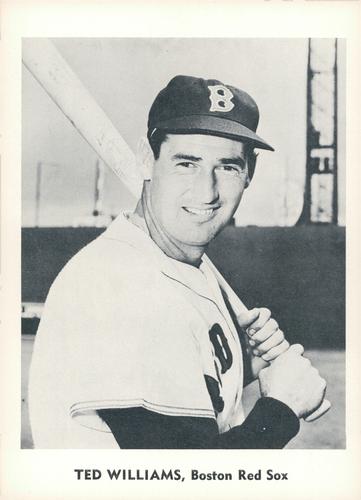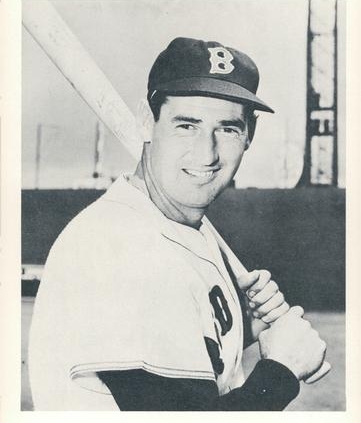May 30, 1959: Ted Williams hits game-winning home run, briefly nudges batting average over .200
 The year 1959 was one Ted Williams may have wished he could forget. He suffered a really bad crick in his neck during spring training in Arizona. It turned out to be a pinched nerve and he was in traction for three weeks.1 He didn’t get into a game until May 12, when he went 0-for-5 with a walk. As June approached, he was still batting under .200, and he had not hit a home run. He entered this day hitting .157.
The year 1959 was one Ted Williams may have wished he could forget. He suffered a really bad crick in his neck during spring training in Arizona. It turned out to be a pinched nerve and he was in traction for three weeks.1 He didn’t get into a game until May 12, when he went 0-for-5 with a walk. As June approached, he was still batting under .200, and he had not hit a home run. He entered this day hitting .157.
The problem persisted throughout the season – the season in which Williams turned 41 years old. He finished the year hitting 95 points below what had been his career batting average leading up to the 1959 campaign, with final totals of a .254 average and only 10 home runs and 43 RBIs.
It was during the Saturday afternoon Memorial Day doubleheader that Williams first cracked .200, going 2-for-4 in each game. He’d started the first game by grounding into a double play and then flying out, but he’d salvaged a degree of respectability with a pair of singles. The Red Sox won, 5-4, overcoming an early 3-0 deficit.
In the second game, Red Sox manager Pinky Higgins gave left-hander Ted Wills his first major-league start. The Orioles’ Paul Richards countered with 20-year-old righty Jerry Walker, who came into the game with a 4-0 record.
A one-out triple by Baltimore right fielder Gene Woodling in the first inning set up the first run of the game. Left fielder Bob Nieman hit a fly ball to center field, a sacrifice fly scoring Woodling. Catcher Gus Triandos doubled, but center fielder Willie Tasby popped up foul to Boston’s catcher, Sammy White, who was starting his first game in a couple of weeks.
With two outs in the bottom of the first, Williams singled – an infield single to second base. First baseman Vic Wertz singled to right field, and Williams ran to third but was stranded there.
The Orioles added another run in the top of the second. Third baseman Jim Finigan led off with a single and went to second base on a groundout. He held at second when Billy Gardner beat out a grounder to shortstop for a single. Walker sacrificed both runners up. With shortstop Chico Carrasquel at bat, Wills threw a wild pitch and Finigan scored. Carrasquel then popped up foul to Wertz, ending the inning.
The Red Sox went down in order in both the second and third innings. Williams grounded out to first base, unassisted, leading off the fourth. Wertz was hit by a pitch but the next two batters popped up.
In the fifth inning, Baltimore bumped its lead to 3-0. With one out, Carrasquel doubled to left field. He took third on another wild pitch, then scored on Woodling’s single to right field.
Right fielder Dick Gernert was the first batter up for Boston in the fifth. He put the Red Sox on the board by homering over everything in deep left field, cutting the deficit to 3-1. Pitcher Wills contributed a one-out double down the right-field line. Don Buddin walked, but Pete Runnels hit into a 4-6-3 double play.
Two Orioles singled in the sixth but neither scored.
Ted Williams was first up in the Boston half of the sixth inning and he got on base with a walk. Two outfield flies followed, then Frank Malzone’s two-base hit high off the left-field wall put runners on second and third. Gernert was walked intentionally, loading the bases. With Sammy White in the batter’s box, plate umpire Larry Napp called a balk on Walker. That scored Williams from third base (and resulted in an agitated Paul Richards playing the rest of the game under protest). The score was now 3-2, the Orioles still in the lead.
In the seventh, Woodling hit a one-out single but Nieman grounded into a double play. Woodling was 4-for-4 in the game.
Wills grounded out and Buddin struck out to start the seventh for Boston, but Runnels doubled to right-center field to put the tying run on base.
Williams followed with his first home run of the season and the 483rd of his career, a two-run homer that gave the Red Sox the lead, 4-3. Wertz lined out.
As homers go, it wasn’t anything majestic. As described in the Providence Journal, it “landed only a dozen feet beyond the foul pole in the near right-field corner and the foul pole is a mere 302 feet from home plate.”2 Bob Holbrook wrote in the Boston Globe, “[I]t was a 310-foot shot that curled around the right-field foul pole”3 – but it was most welcome nonetheless.
“For sheer distance,” the Boston Herald’s Arthur Sampson wrote, “this probably was one of the shortest homers of Ted’s career, but it was hit with his old-time authority as were several other drives stroked by him yesterday.”4
Baltimore attempted to rally in the eighth when Tasby singled to left with one out, but Wills induced groundouts – both of them resulting in force plays at second base – by Finigan and Whitey Lockman.
The Red Sox added four insurance runs in the bottom of the eighth. Jackie Jensen led off with a double to right field and Malzone singled to left. Still in a one-run game, Paul Richards called in a reliever, Jack Harshman, who walked the first man he faced, Dick Gernert, loading the bases.
White cleared the bases with a double just inside the third-base bag and into the left-field corner. Wills bunted back to Harshman, sacrificing White to third base. Buddin popped up to first base, but Runnels singled to right field and White scored with ease. The Red Sox had built an 8-3 lead.
Still in the game, Ted Williams had been told that the four hits he had in the two games had brought his career hit total to 2,499. He was aware of that when he came up to bat and hit a fly ball to deep center field, caught by Tasby on the warning track. It had almost reached the wall, but it was hit into a stiff wind and hadn’t been hit quite hard enough.5 It went for the third out.
Heading into the ninth, Jim Busby took up position in center field for the Red Sox, Williams leaving the game. Gernert moved from right field to left, and Jensen moved from center field to right.
Ted Wills was still in the game. Gardner fouled out to catcher White. Albie Pearson pinch-hit for Harshman and field out to Jensen in right field. Carrasquel popped up to Runnels at second base and the game was over.
Wills got the win, his first big-league victory. He finished the season 2-6 (5.27) for the fifth-place Red Sox.
Even though he debuted during July 1957 and pitched in 1958 and 1959, too, this game was Walker’s first loss in the big leagues. He’d been 5-0 in his career to this point. Walker finished the 1959 season 11-10, despite a very good 2.92 earned-run average. The Orioles finished in sixth place, just one game behind the Red Sox in the league standings.
Williams’ sixth-inning home run had given the Red Sox the lead. It proved to be a lead that held. As in the first game, the Red Sox had been down 3-0, but overcome the deficit. The homer was the 101st game-winning home run of Ted Williams’s career.6
Baltimore won Sunday’s game, 2-1, former Red Sox pitcher Hal Brown holding Boston to just four base hits.
The Red Sox had been short of outfielders, so Ted Williams did play both games on Saturday. It was the first time in three years he’d started in both halves of a doubleheader. He played all but the ninth inning in each game. He was 0-for-3 on Sunday, but a double on June 2 got him to 2,500 hits (and drove in a run).
The game officially gave Williams 20 years of major-league service time.7 With the four hits in the doubleheader, he nudged his average up to .203, the first time he exceeded .200 in the 1959 season. It dipped down to .194 the following day. It wasn’t until nearly a month later – on June 26 – that he got it above .200 to stay. By season’s end, Williams had lifted his batting average to .254.
Acknowledgments
This article was fact-checked by Mike Huber and copy-edited by Len Levin.
Sources
In addition to the sources cited in the Notes, the author consulted Baseball-Reference.com and Retrosheet.org.
https://www.baseball-reference.com/boxes/BOS/BOS195905302.shtml
https://www.retrosheet.org/boxesetc/1959/B05302BOS1959.htm
Notes
1 Ted Williams with John Underwood, My Turn at Bat (New York: Fireside Books, 1969), 205.
2 F.C. Matzek, “Ted Gets HR, 3 Other Hits as Bosox Win Two,” Providence Journal, May 31, 1959: S-1.
3 Bob Holbrook, “Ted’s 1st Homer Aids Sox Sweep,” Boston Globe, May 31, 1959: 67.
4 Arthur Sampson, “Ted Sparks Sox Twin-Win,” Boston Herald, May 31, 1959: 55, 56.
5 “Someone told me about the possibility of the 2500th hit that last time up,” he said. “But don’t worry, I’ll have a lot more good days before this season has finished.” Henry McKenna, “Williams Fully Confident More Good Days Ahead,” Boston Herald, May 31, 1959: 56. Sampson mentioned the wind as a factor.
6 A “game-winning home run” is defined here as a home run that provides a game’s final margin of victory, giving the winning team at least one more run than the opposing team scored. For example, if a two-run homer increased a team’s lead from 2-1 to 4-1, and they went on to win 4-3, it qualifies as a game-winning home run. (This is different from the definition of “game-winning RBI” in baseball’s official statistics from 1980 through 1988, which counted as “game-winning” the RBI that provided a winning team the lead that it never relinquished.)
7 He had received credit for the years spent in military service but hadn’t achieved the milestone until this date in May because he had been several weeks late in reporting a few years earlier pending divorce proceedings.
Additional Stats
Boston Red Sox 8
Baltimore Orioles 3
Game 2, DH
Fenway Park
Boston, MA
Box Score + PBP:
Corrections? Additions?
If you can help us improve this game story, contact us.


